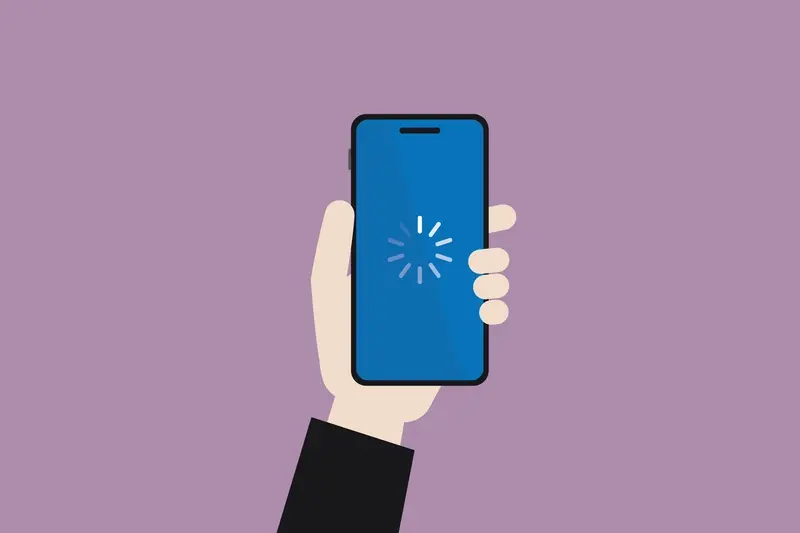What's Included In Ongoing App Maintenance?
95% of mobile apps lose all their users within 90 days of download. That's a staggering number that highlights just how competitive the app space has become. But what separates the 5% that succeed from the 95% that fail? One key factor is ongoing app maintenance.
When most people think about building a mobile app, they focus on the initial development—the design, the features, getting it live on the App Store or Google Play. That's understandable; it's the exciting bit where you see your idea come to life. But launching your app is just the beginning, not the finish line.
The real work starts after your app goes live—that's when you need to keep it running smoothly, secure, and relevant to your users' needs.
Think of ongoing support as the difference between buying a car and actually owning one. You wouldn't buy a car and never change the oil, update the software, or fix problems when they arise. Your mobile app needs the same kind of attention. Service coverage includes everything from fixing bugs and updating security to monitoring performance and keeping up with new operating system requirements. Without proper maintenance, even the most brilliant app will struggle to survive in today's competitive market.
Understanding the Basics of App Maintenance
When I first started developing mobile apps, I naively thought the hard work was done once we launched. How wrong I was! That was just the beginning of a much longer journey—one that requires ongoing care and attention to keep your app running smoothly.
App maintenance isn't just about fixing things when they break (though that's part of it). It's about keeping your app healthy, secure, and relevant in an ever-changing digital world. Think of it as regular health check-ups for your app, making sure everything is working as it should be.
What Does App Maintenance Actually Include?
The scope of app maintenance covers several key areas that work together to keep your app functioning properly. Each area plays an important role in your app's overall health and user satisfaction.
- Bug fixes and performance improvements
- Security updates and patches
- Operating system compatibility updates
- Server monitoring and infrastructure management
- App store compliance and submission management
- User feedback analysis and feature updates
- Analytics monitoring and reporting
The reality is that mobile operating systems update regularly—iOS and Android release new versions throughout the year. Your app needs to stay compatible with these changes, or you risk losing users who can't run your app properly on their updated devices.
Server Management and Technical Infrastructure
Behind every mobile app that runs smoothly sits a complex web of servers, databases, and technical systems that most users never see. When your app loads instantly or saves data without a hitch, that's the server infrastructure doing its job perfectly. But here's what many business owners don't realise—this technical backbone needs constant care and attention to keep working properly.
Your ongoing support team monitors server performance around the clock, watching for slowdowns, crashes, or capacity issues that could affect your users. They're also managing database backups, applying security patches, and scaling resources up or down based on how many people are using your app. Think of it like maintaining a car—regular servicing prevents breakdowns before they happen.
Server costs can fluctuate based on user activity, so work with your development team to set up monitoring alerts that catch unexpected spikes before they impact your budget.
What Server Management Includes
- 24/7 server monitoring and uptime tracking
- Database maintenance and regular backups
- Content delivery network optimisation
- Load balancing and traffic distribution
- Storage management and capacity planning
- API maintenance and third-party integrations
The technical infrastructure supporting your mobile app isn't just about keeping the lights on—it's about ensuring your service coverage remains consistent as your user base grows and your app evolves over time.
Security Updates and Data Protection
Let's talk about something that keeps app developers like me up at night—security vulnerabilities and data breaches. Your app isn't just a piece of software sitting quietly on someone's phone; it's constantly communicating with servers, handling personal information, and potentially storing sensitive data. That makes it a target.
Security updates form the backbone of any proper maintenance plan. We're not just talking about the occasional patch here and there—this is ongoing, systematic monitoring of your app's security landscape. Every month, new vulnerabilities are discovered in operating systems, third-party libraries, and frameworks that your app relies on. When iOS or Android releases a security update, your app needs to be tested and potentially updated to maintain compatibility and security standards.
What Security Maintenance Actually Includes
The data protection side goes much deeper than most people realise. We're constantly monitoring for unauthorised access attempts, unusual data patterns, and potential breaches before they become serious problems.
- Regular security audits of your codebase and infrastructure
- Updating encryption protocols and security certificates
- Monitoring for suspicious user behaviour and access patterns
- Implementing new privacy regulations as they emerge
- Testing authentication systems and payment gateways
- Backing up and securing user data according to compliance standards
The truth is, security isn't a one-time job—it's an ongoing relationship with your app's digital wellbeing. Without regular security maintenance, you're essentially leaving your front door unlocked in a neighbourhood where the crime rate keeps going up.
Performance Monitoring and Bug Fixes
Right, let's talk about something that can make or break your mobile app—keeping it running smoothly. Performance monitoring isn't just about watching numbers on a dashboard; it's about making sure your users don't get frustrated and delete your app after five seconds of waiting for it to load. Trust me, they will!
When we monitor performance, we're tracking things like how fast your app opens, how much battery it drains, and whether it crashes randomly. These metrics tell us a story about what's working and what needs fixing. The tricky bit is that problems don't always show up immediately—sometimes they only appear when thousands of people are using your app at once, or on specific devices you didn't test.
Spotting Issues Before Users Do
Bug fixes are where the real detective work begins. Every mobile app has bugs—yes, even the ones that cost millions to develop. The difference between good ongoing support and poor service coverage is how quickly these issues get identified and sorted. We use monitoring tools that alert us when something goes wrong, often before users even notice.
A bug that affects one user today could affect a thousand tomorrow if left unchecked
The goal is to catch performance problems early and fix them fast, keeping your app running like a well-oiled machine.
User Experience Updates and Feature Improvements
Apps that don't evolve get forgotten—it's that simple. I've watched brilliant apps lose their entire user base because they stopped updating their experience. People's expectations change constantly and what felt cutting-edge six months ago can feel dated today.
Your maintenance package should include regular UX reviews and feature updates based on user feedback and analytics data. This isn't just about adding shiny new buttons; it's about making your app easier and more enjoyable to use. We analyse how people actually navigate through your app, where they get stuck, and what they're asking for in reviews.
Types of UX improvements we typically handle
- Streamlining navigation flows that confuse users
- Updating interface elements to match current design standards
- Adding new features based on user requests
- Improving accessibility for users with disabilities
- Optimising layouts for different screen sizes
- Refining onboarding processes to reduce drop-off rates
The best part about ongoing UX updates is that they compound over time. Each improvement makes your app slightly more sticky, slightly more engaging. Users notice when an app feels fresh and responsive to their needs—they're much more likely to stick around and recommend it to others.
App Store Management and Compliance
Managing your mobile app in the app stores isn't a set-and-forget task—it's an ongoing responsibility that requires regular attention. Both Apple's App Store and Google Play have strict guidelines that change regularly, and staying compliant is part of your ongoing support requirements.
Your app maintenance team needs to monitor these policy updates constantly. What was acceptable last month might violate new rules today, and non-compliance can result in your app being removed from the stores. This monitoring includes everything from privacy policies to content guidelines and technical requirements.
Key Store Management Tasks
- Updating app descriptions and screenshots when features change
- Managing app store reviews and responding to user feedback
- Submitting updated builds for approval after updates
- Monitoring compliance with evolving store policies
- Managing app store optimisation to maintain visibility
- Handling age rating updates when content changes
Set up automated alerts for app store policy changes—both Apple and Google provide developer newsletters that will save you from nasty compliance surprises.
The review process alone can take several days, which means any urgent fixes need to account for approval time. Your ongoing support service should include buffer time for these delays and have processes in place for expedited reviews when needed.
Analytics and Reporting Services
Right, let's talk about the numbers—because if you're not measuring what's happening with your app, you're basically flying blind. Analytics and reporting services are like having a detailed diary of everything your users do; they tell you which features people love, which ones they ignore completely, and where they get stuck or frustrated.
During ongoing app maintenance, your development team will set up and monitor various analytics tools that track user behaviour, app performance, and business metrics. We're talking about things like how many people download your app each day, how long they spend using it, which screens they visit most often, and—this is the big one—where they decide to give up and close the app.
Making Sense of the Data
The tricky bit isn't collecting the data (that's the easy part), it's interpreting what it all means. Your maintenance team will create regular reports that break down complex statistics into simple insights you can actually use. For example, if the data shows that 70% of users abandon your app on a particular screen, that's a clear sign something needs fixing.
Turning Insights Into Action
The best part about having proper analytics? You can make decisions based on real user behaviour rather than guesswork. Maybe you thought users would love that fancy animation, but the data shows it's causing people to leave—time to rethink that feature!
Conclusion
After working with hundreds of clients over the years, I can tell you that ongoing app maintenance isn't just a nice-to-have—it's what keeps your mobile app alive and kicking. The apps that thrive are the ones with proper ongoing support backing them up; the ones that fail often do so because their owners thought launching was the finish line rather than the starting point.
We've covered quite a bit of ground here, from server management and security updates right through to analytics and App Store compliance. Each piece plays its part in keeping your app running smoothly. Security patches protect your users' data, performance monitoring catches problems before they become disasters, and regular updates keep people interested and engaged with what you've built.
The thing is, mobile app maintenance isn't a one-size-fits-all solution. Your service coverage needs will depend on your app's complexity, your user base, and your business goals. Some apps need daily monitoring whilst others can get by with weekly check-ins. What matters is having a plan that matches your specific requirements—and sticking to it. Trust me, your users will notice the difference, and more importantly, they'll stick around because of it.
Share this
Subscribe To Our Learning Centre
You May Also Like
These Related Guides

Whats The Total Cost Of Owning An App Long Term?

Should I Tell Users When I've Fixed A Bug In My App?



